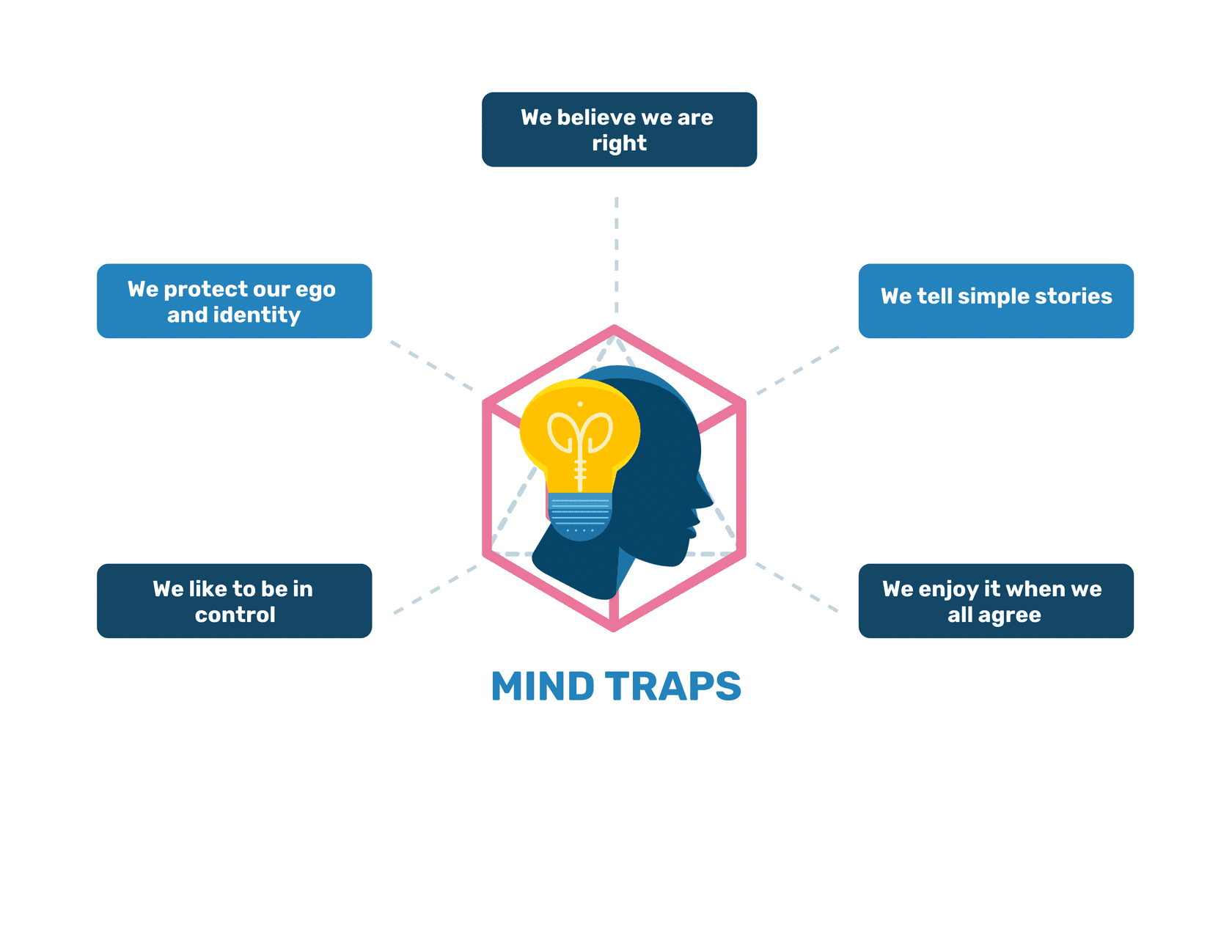80 Mindtraps and Informal Barriers to Change
The Mindtraps activity is an important section for you. The time spent is essential and is time well-spent. You can also suggest to others around you and in your teams to work on this section. Collective insights are so valuable when it comes to change!
Find the informal barriers when navigating change
In earlier topics, we highlighted some of the psychological responses to change, including the fact that people sometimes avoid the uncertainty associated with new ideas or ways of working as our brain may read this uncertainty as a kind of personal risk. In this topic, we would like to explore in a little more depth some of the internal interferences or mind traps that we might need to acknowledge when we are seeking to drive through change or new ideas at work.
Developmental psychologists Robert Kegan and Lisa Lahey1 explore some interesting reasons for our tendency to resist certain elements of change in their book ‘Immunity to Change’2. The book uses a range of powerful metaphors to help people explore what is really going on when humans demonstrate resistance. As a starting point, it is useful to remember that one of our brain’s primary roles is to protect us. As such, any sense of danger or risk is something that our brain might naturally tend to be cautious about. Interestingly, these human responses to change served our ancestors very well when needing to make quick decisions about hunting, safety or danger; but can be limiting for us as we navigate what is a much more complex world in both our work and social lives.

Kegan and Lahey suggest that we need to explore the ‘hidden interferences’ and ‘big assumptions’ that we might be making about a situation in order to overcome personal or group resistance. As an example, we might have a big assumption that ‘I’m not senior enough to influence any real change around here’. This assumption reinforces a sense of powerlessness and can encourage us to not even bother to try new things.
Often at work, you might here signs of these interferences in the chat of social groups.
-
bullet
‘You have to be a senior officer before anyone will listen to you’
-
bullet
‘We’re not allowed to drive any new ideas or innovation’
-
bullet
‘That could never work here’
Have you ever heard this kind of chat in your own work environment? Effectively, this kind of narrative lets us off the hook in some ways as it reinforces a view that we should just leave things as they are!! This of course would be a terrible mindset for any HRO or high- performance culture.
Consider your own work environment. When have you observed people embrace change and new ideas very readily? When have you observed resistance?
What might be one or two clues for you in how to overcome some of the informal barriers to change in relation to your own idea highlighted in the @Work activity
Mindtraps for change
Another way of thinking about this idea is offered by writer and leadership expert Jennifer Garvey Berger in her book ‘Unlocking Leadership Mindtraps’3 She also explores the notion of resistance to change; and the sometimes primitive responses of our brain to protect us and make sense of the world when under pressure. Once again, she highlights the need for a new way of thinking when confronted by the complexity and ambiguity of modern work and life.
She believes that in navigating a world of complexity and change there are five mindtraps we must all pay particular attention to that can cloud our thinking in relation to driving alternative perspectives and thinking critically about complex situations.
Click the arrows on the image below to unpack the five mindtraps.

Numbered divider 1
Watch this short video clip animation where Jennifer Garvey Berger introduces the five Leadership Mindtraps, why we’re designed to fall into them when we are in complex environments, and how to escape them.
Pay particular attention to the ways in which to escape these mindtraps and how they might be relevant to your own complex situation.
Numbered divider 2
In your journal, consider which of the mindtraps might be a blindspot for you as you approach your new idea for change.
Numbered divider 3
Consider some simple strategies for paying attention and escaping the mindtraps that might be at play.
References
- Kegan, R., Lahey, L. L., Miller, M. L., Fleming, A., & Helsing, D. (2016). An Everyone Culture: Becoming a Deliberately Developmental Organization. HBR PRESS.
- Kegan, R., Kegan, L. L. L. R., & Lahey, L. L. (2009). Immunity to change: How to overcome it and unlock potential in yourself and your organization. Harvard Business Press.
- Berger, J. G. (2019). Unlocking leadership mindtraps: How to thrive in complexity. Stanford University Press.


